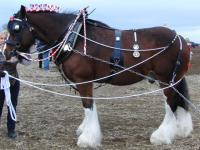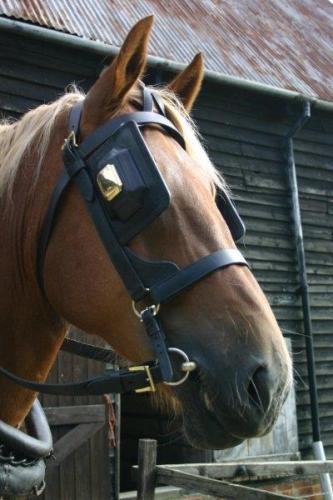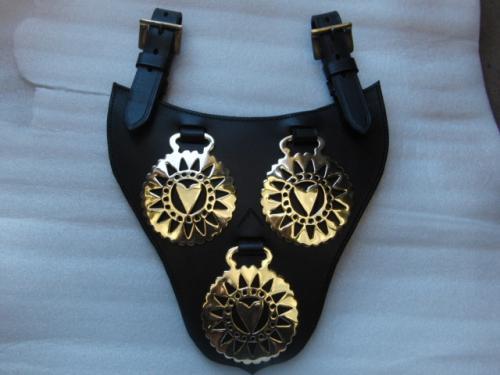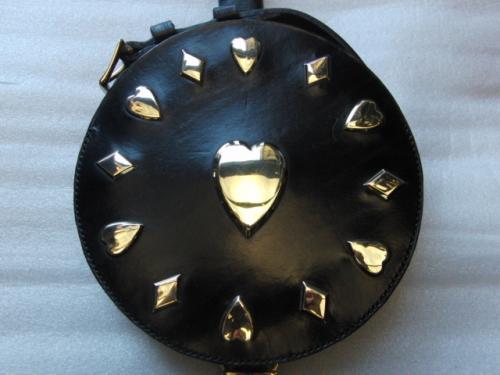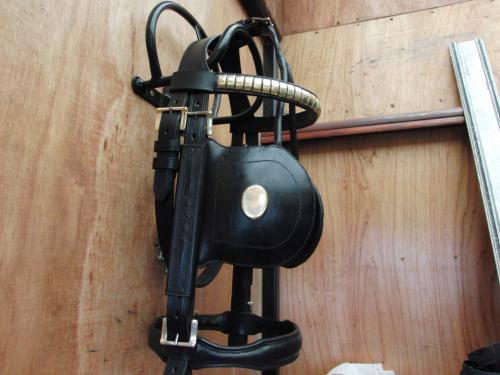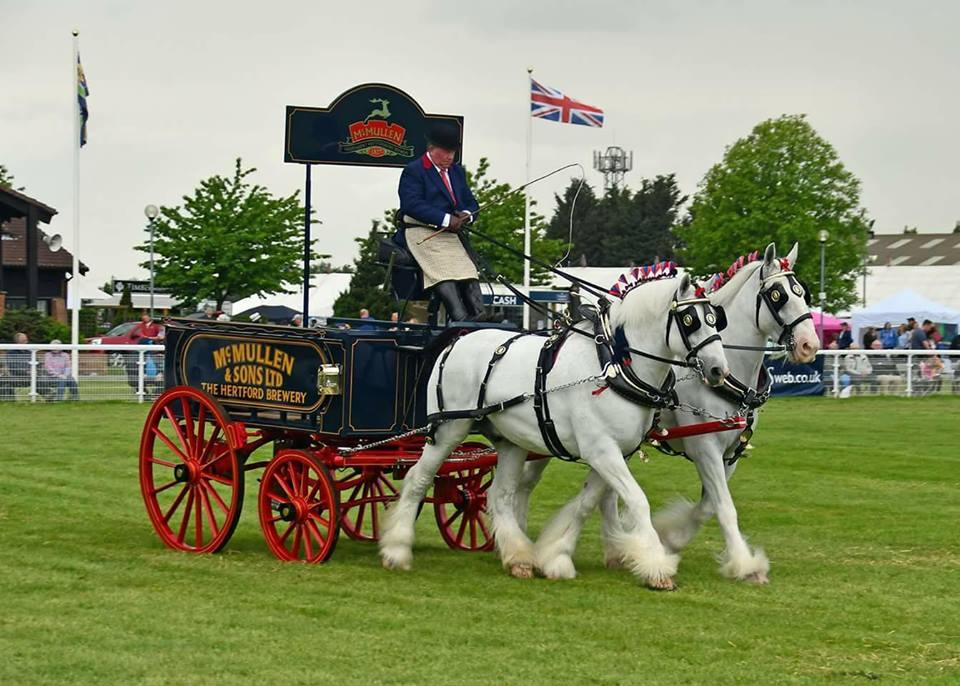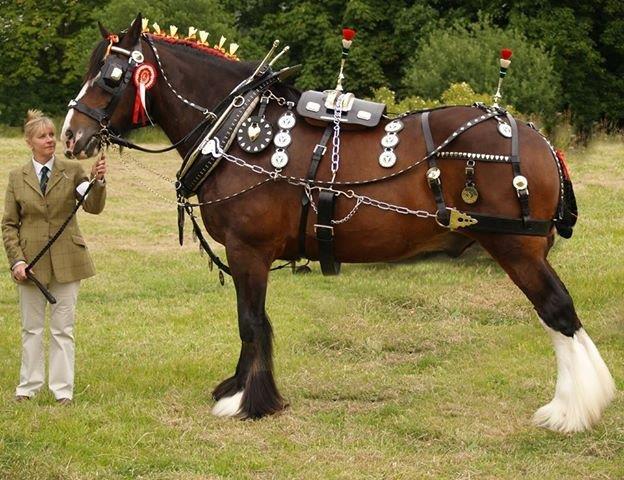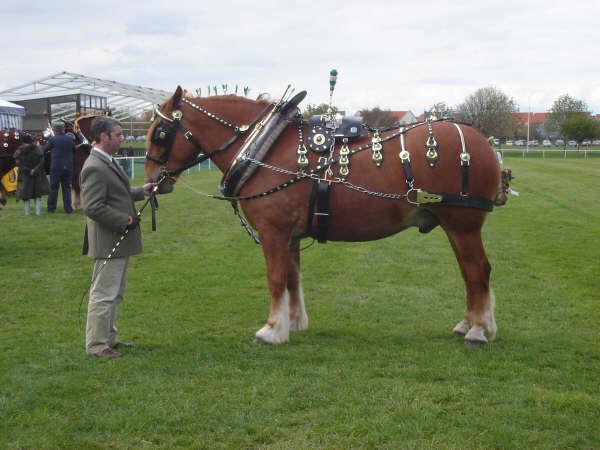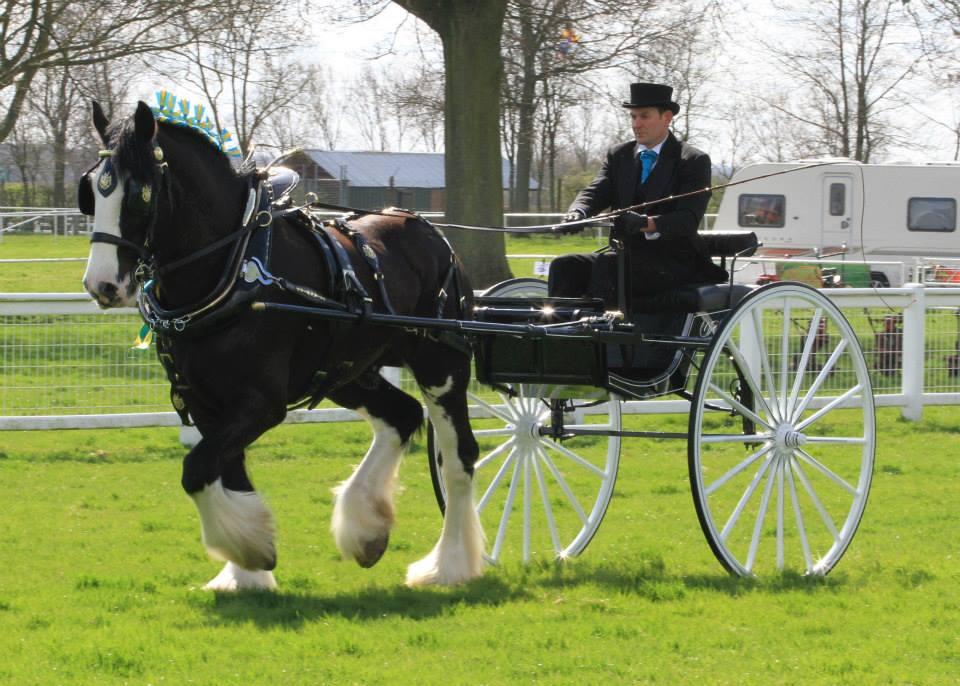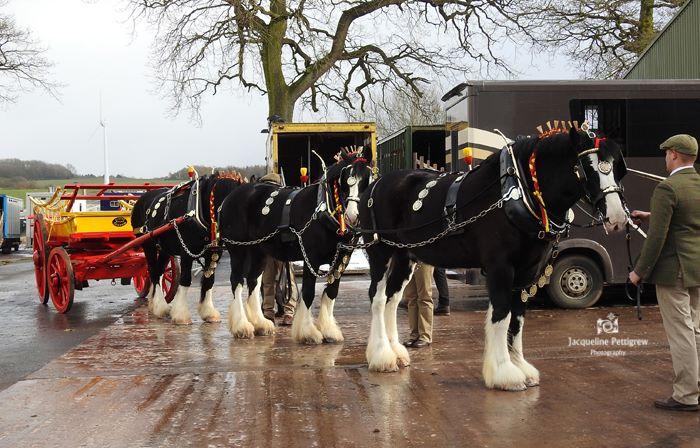-
Posts
42 -
Joined
-
Last visited
Content Type
Profiles
Forums
Events
Blogs
Gallery
Everything posted by philg9
-
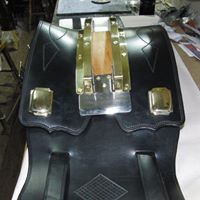
Basic Saddle Stitch Tutorial By Nigel Armitage
philg9 replied to immiketoo's topic in Sewing Leather
Indeed, heavy leathers is not so common thee days but thankfully Bakers stil provide what I need. I cannot be doing with Veg tan for my work, it isnt half the leather of the oak bark in strength and dsurability. Heavy horse harness made form Veg tan stands out like a sore thumb, so not the right leather for it, so much so it does not even look right. As for TPI is typical. Most all heavy strap work like breeching seats and crippers, the breeching back strap, all retaining straps like brake straps, chain carrying straps that all feel the force of a ton of horse are done at 6 TPI, 6 is the magical number as it isnt course looking like a 5 TPI would be but still has full strength as your likely to get and it still leaves plenty of leather between each stitch. If heavy thick straps are sewn to close like 8 or 9 TPI then it weakens the leather somewhat. Next I use 7 TPI a lot for hame straps to latch the hames onto a collar, all driving reins, Bridle cheeks etc martingale and other decorative straps and parts, Clincher brow bands although will use 8 TPI for a brow band to go in a more refined set , then for some finer nose bands, more decorative parts especially on patent leather decorative parts especially for show harness I will use 8 TPI, then occasioanlly if I am making some decorative parts that are to be something that bit more special then I will occasionally break out a 9 TPI, so it is a combination of those three sizes mainly, I have irons up to 18 TPI but I dont ever use that fine, they just make the irons look a completr set on a tool board above my bench. They are all old irons as one thing that drivs me wild is the modern made irons, most of them have a teeth width that is far too wide for me. I much prefer narrow teeth irons. With those, you mark your stitch marks with them then after you have stitched through the work, the teeth are that wide you can still see the ends of the slants top and bottom of the stitch, this makes any piece of work have an ugly finish, just doesnt do it for me, also folk who punch awl holes far too big then necessary, then when you look at the stitching afterwards, you can see the thread but it's in a dirty great gash. with heavy horse harness, one thing that needs to happen is once you have pulled each stitch tight, it should close the hole you awled up a bit adding to the strength. -

Basic Saddle Stitch Tutorial By Nigel Armitage
philg9 replied to immiketoo's topic in Sewing Leather
I suppose everyone has teir own way woith theor stitching, and for me,. that is based oin the type of work I do. As it is all heavy horse ( draught ) horse harness and tack, I am often working wiith thicker heavier leather than most other work where at times with strap work, it's 3 layers of 4 MM harness backs prepped, tacked up and hand sewn in the full 3 layers making anything from 15 - 18mm in total. It's technique much more than brute force and well polished awls. also bearing in mind is the job this harness has to go and do. It has to contend with a ton of horse of a single set of harness, coveriong strength, durability and as much if not more the fit and comfort for a heavy horse in work in work hauling heavy stuff and ploughing etc. The stitching has to reflect the rigours the harness will go through. Things like awl hole size are important on heavy horse harness, too big a awl hole is not so good for my work as I want as much leather between the stitches for strength. I see other leather work and the leading and lower ends of the slants the awl leave are wider than the row of laid stitches, wider slants help more to get a more pronounced herriong bone look to the stitch. Thread, I always use Somac waxed linen thread, 3 / 18 4 / 18 and 5 / 18 is the three common soze threads for me , Tiger thread is harsher on the surface of the raditional oak bark tanned hides I use from Bakers in Devon, UK, Tiger thread can have a tendency to cut through the surface especially when certain parts of the harness are really being put through its paces and the horse is working hard. I make ,my own wax from traditional pitch, beeswax and Rozin and melt it down and ball it up in cold water, no wax is beter for harness work and with the linen thread it works the best for strength as when stitching woith linen thread and proper harness waxed thread when you pull the stitches through it melts the wax a bit and then after some time, the wax sets hard around the thread which in time creates what is call a post inside the leather, makes like a cement which has extra grip to keep the leather together and stong even of the outer part of the stitch has worn away over the years in use. One thing when stitching, I work form the fornt of ny work, that's how my hands work best to do saddle stitch, I'll put the grain sode needle through forst, cross the needles over on the flesh side then the second needle is passed throiugh while pulling the thread of the first needle with it then when the second needle is half way through, I have the thread of the first needle in my right hand then I will make a clock wise loop over the second needle then pull the second needle through the loop then lay the stitch as usual, this creates what I suppose is a lock stitch insode the leather much like a sewing machine, but the purpose of doing this loop over the second needle each stitch is that this is what melts the wax I run the thread through pre stitching to then become what is the post inside the leather, If I didnt loop it so the two bits of thread inside the hole are not entwined as it were, the two thread sections would be seperate, if the stitching wears and or breaks the thread would just peel undone whereas by making this loop over the second needle each stitch, if the thread does break or wear on the oiuter surface then the post that is cemented from the wax inside the leather, then this will keep the leather together, it just makes it stronger again all round durable stitch. -
Just to add for that final polish to really iron out any last remaining scratches etc is to use the brand of metal polish callled ' autosol ' It is woidekly available and it is a paste like toothpaste in a toothpaste type tube, using this on a strop only for final polishing with Autosol is a miracle in a tube, nothing else does the last bit of final polishing like this paste.
-
Cheers Domsleather and yes, dedication is what it takes and i have that in bucketloads.
-
This is the above 7 inch pictured on the left against an old Blanchard 8 inch on the right. The pics were taken as I bought them before I put them to the strop to bring them up to speed. Me personally I much prefer the round profile on the front leadoing edge, some folk prefer a more flat profile. Metals used in modern made knives cannot come anywhere near to the performance of old knives and the only recommendation I can give folk is to save your money, be patient and keep your eye out for old ones at least 40 years plus and preferably pre 2nd world war or thereabouts, you wont regret it. In the USA for pricing equivalent, if you see an old Blanchard for $150 grab you self the best freind you'll ever likely to have.
-
This old Blanchard is 7 inches across the tip's and for skiving down the ends of wide straps like plough back bands, as the metal is thin, its performance and keeping a keen edge is superb.
-
Ah the round knife, this is a thing that is close to my heart as it is oine of the back bone sof my daily life as a harness maker. Without a round knife, my world would not be complete. Over the years I've been through all sorts, learnt lessons and had my fingers burnt ( and cut them ! yes, the trick is to learn how not to cut yourself with these ) I do have my views on these but it all depends what you want a round knife to do and what leathers you are working with. I only use my round kniives for skiving the ends of straps of various widths right up to 5-6 inches wide for certain parts of the harness I make. I never use them upright on the point to cut long strips or to cut out shapes. If I saw someone using one of my round knives for this I would ask them to put the knife down and never do that agin. A half head knife is there for that job. What do I feel is the best and the worst. This has only formulated through 25 years of hard learnt experience. First off. Modern made ones, me personally I would not entertain them in my workshop for the work I do. I only work with English oak bark tanned leathers from Bakers in Devon and work with anything from 2 MM shoulder through 4 and 5 -6 MM heavy harness backs and bridle leathers. ( I apologise to folk in the USA, I have no idea what the equivalent MM is in OZ weight, in the UK, we work in thickness not weight) I need a knife that is finer in weight, as in the thickness of the metal, this varies greatly and thicker metal blades do not do it for me, skiviong down heavier leather see's the kniofe kiond of jam or wedge when you start skiving, a thinner blade is much more condusive for a nice smooth action. Most modern blades for me are too thick. ~They tend to need a bigger bevel to gain an edge whereas a thin metal blade knife has much less of an angle, it is this one thing that makes a blade more condusive to cut like butter, with thick blade knives you have to push much more to get a noce skive going, a thick blade is going to be better for using upright on the points for cutting strips or shapes if you wish to use one for that. For me personally, the only round knives I will entertain having for every day use is the old European makes, like 40-50 years plus in age. The quality of the steel far excels any other round knife I have tried and used, and are better again than old Dixons or Barnsley's. There were many European makers at one time but for me Blanchard stand out from the rest. Modern Vergez Blanchard are crap compared to the old originals. My favourite and best knife I have for everyday use for quality, thickness of metal which is thi and is perfect for me and the ability to hold the best edge that really is razor is an old French Fries Bost. If a knife is old, classed as antique, European made like French, German, Belgian, Swedish etc then you will have a best freind for life and you will never need to look for another one. I cannot bring myself to recommend new modern knife makes to anyone as I have handled many over the years, various knives owned by various people or ones I've bought before I ended up with the ones I have. Everyones learning curve is to go through them until you find what works best for you and old is best for quality of steel, even what folk think is the best modern made knife, it still will not be a patch on old ones. I do have a small modern Osbourne, it came woith another tool I was after, I wouldnt have bought the knife if it was on it's own, I'm not being rude but it is the worst thing I've ever had a go with, it has about the same very poor edge performance as stainless steel , in the fact the steel is way too thick and it just does not keep an edge no matter how hard you try. it's not for me, I've almost threw it in the bin twice, I bet old Osbourne far excell modern ones, I havent used an old Osbourne. Modern solingen knives, not for me, the ability to hold and maintain an edge is almost non existant and when you do get one I find I have to keep stropping it every 2 minutes, I have a modern Soliongen half head knife and it is crap. I also have a modern Don Carlos French pattern head knife, again, it is crap, it is good for hacking at rough stuff though. I have an old Dixon and a modern one I got stuck with as just before Dixons closed they were offering really knock down prices to shift stock, the modern one needs melting and turning into cooking untensils as that's all its good for. Yes I have a bit of a collection of round knives I've ended up with from over the years in the search to find what suits me best. I also have a modern Barnsley, again hardly worth the steel it was made with, and again, an old original Barnsley is really good. Many folk I have discussed round knives with have all said that once they have found their way to old antique aged European ones they have mever gone back or looked for anything else. I use 4 different width's of Old Blanchards from 4 3/4 inches across the tips up to 8 inch across the tips for skiving wide straps and the Bost round knife. they do come up for sale of you keep your eye out and are priced differently according to the sellers idea of worth. I have bought and kept the round knives I have that have passed the test for being a go to knife, anything from £40 for a lucky find up to £120 for a very old Blanchard that is in very good condition as in the blade hasnt been wrecked and re shaped or poorly sharpened over the years. The picture is an old Blanchard 4 3/4 across the tips
-
Got it Tom, thanks. I do usually check what I have typed before I hit the send button to iron out text but the occasional typo escapes. I've never posted anything I regret on line so will be safe wth the 2 hour slot lol.
-
Cheers Toxo, could see a couple of typo's in line 7 of my intro but couldnt see one that ralted to goats lol, the word stitching is typo'd,, cnt see an edit button as I do like to re do typos. As for passing knowledge on, that will happen in a few years when I will want to start slowing down, just havent the time to do training/one to one. I have done a few student days for those going through Capel Manor but to train someone who has the intrest in heavy horse harness form scratch is very time consuming and would divert fiom me getting orders out on time. To work with heavy horse harness, ideally someone needs some hands on harness work experience with the horses to gain an understanding the mechanics of it which is quite important and I would expect someone to have that if I was going to pass it on. General leather work would be less time consuming to pass on
-
Hi Emma Ah yes, am quite prolific on facebook. I have written a few bits oin face book recently regarding terminology of what people call hand made, made to measure, ther eis very mis leading adverts form retailers etc as you have found by buying something that was called hand made but of poor quality, sorry to read this. And yes, a lot of dog collars widely retailed are poor quality. Drop me a message on face book to chat on there if you want as will look in here when have time but face book is the main portal to be in touch with customers and horse owner freinds.
-

Are expensive whet stones worth it?
philg9 replied to Artificial Intelligence's topic in Sharpen it!
As far as my harness tools go. I never use any of what is termed as the traditional oil sharpening stones,also known as carborundum stones if you want to ruin your tool edges, go right ahead. The only one I use now is an Eze Lap diamond stone, it is a slab of stainless stell with doamoind dust coating embedded in the top surface. to create a new edge or re edge, this is the only one I'll use. If i caught anyone putting my tools on an oil stone thye would end up wearing it. i only go to the Eze lap when an edge really does need re doing. After that and for general everyday maintenence, it is the leather strop board. On one side I have a piece of something like 1.5 MM panel hide glued onto the board, flesh side up and I rub fine jewellers rouge onto the leather, this keeps half round knives ( head knives), skiving knives, clicker blade knives lovely and smooth with no burrs, once been over this, on the other side of the board i have another piece of panel hide glued on, flesh side up woith nothing on it, just plain leather, I then put the blade on thos for a final polishing. Nothing else keeps my tools toip top razor sharp so they are ready to go whenever i need to use them. Then after that, if they do need a final polish to really take out and final marks to really get a high polish and avery keen edge, I have another strop board, again with a pice of panel hide glued on flesh side up, and I alwayskeep the brand of metala polish called " Autosol " this is widely available everywhere, it comes in a toothpaste size tube, smear a little blob onto the leather and smea rit around a bit to cover the sized area the blade will need then goive it a final stropping on the Autosol, nothing I have found will take out and final scores and marks you cant see with your naked eye and will take off any final tiny bits of burr to then leave your tol gleaming, polished and if you done it right with the right angle for whatever blade you are working on, be careful of your fingers. I use the above methods on my splitter blades, works a treat, takes a bit more work as these blades are old and harder steel but the Autosol does good for the final few sweeps. With the leather strops and jewellers rouge,you do not need to apply hard pressure, it's better with a lot more gentle sweeps rather than a few hard grinds. -

Help! Sharpening French edge skiving tool
philg9 replied to Michellleatherworks's topic in Sharpen it!
The best way to hone the top edge of a French skirt shave is once you have the inder sode done on a strop, to take any upward facing burr off is cut a strip of leather, bridle keather will be fine, make it the same width as the inside of the flat blade so it sits snug between the forward facing guides, then with this strip, run it through you splitter and thin it down so you have a strp about 2 MM thick and use the strip that was the flesh side, then on a spare bit of bench, tack one end of the strop so it hangs down and with the spilt part facing upards. you can use the leather plain or rub a bit of finest jewellers rouge on it, then what you do is turn your French skirt shave upside down, and lay it on the leather strip near to where you tacked it to the surface and have about 12 inches of strip hanging down, press the blade onto the leather with your thumb and curlyour fingers underneath to hold the strip into the blade, then what you do is run the blade down the strip of leasther while retianing the striop onto the blade with your finger and thumb. You dont want to have much angle, just enough so the strip of leather runs over the edge as you run the blade down the strip. I have different width strips for dofferent width skirt shaves. Once you've done thos then you cn go back to the strop with fine jewellers rough to finish off the under side. Repeat if necessay. It will take you a bit of practice but I assure you once you have got to grips with it this will hone and keep your skirt shaves in tip top condition mpre so than ever. Let me know oif you want pictures, will get some to you. For edge shave tools, the best way to hone inside the little groove is a similar methid but what you do is cut a bit of tiger thread which is best for this, not too thin either, cut a length of thread about 18 inches long, tie one end of the thread to anything you have handy, like a hook in a bench a drawer handle etc, then rub a little bit of fine jewellers rouge onto the thread, then with your edge shave, turn it upside down, then near where you tied the thread, place the thread in the groove and hold in place with your thimb and finger and then run the tool down the thread, not too steep an angle and just enough so the thread runs over the edge of the cuttng edge, do this say 4-5 times if its burred, thios thread method will really sort the edge in the groove, then put the under side on a leather strop and draw it backwards, then re run it on the thread, again with practice, this is the best way to sharpen edge shave, it works on hollow ground edge shaves as well -
Hi Uppy27, I'm a harness maker in the UK, Abbey saddlery do stock strap cutters, I have a feeling it is a different version than the one in your picture but in essence it will do the same job. they used to sell the name marked ' strap-cutter' Here is the link to the strap cutter on Abbey website https://www.abbeyengland.com/strap-cutter-10215.html
-
-
To introduce myself, My name is Phil and I am a long term Harness maker working full time from my workshop in the U.K, specializing in heavy horse harness. I have always had a passion for the heavy breeds of horses as we have the Shire horses, Clydesdales, Suffolk Punch, Percherons and Belgian Draft horses. My career started off about 25 years ago after having owned and worked Clydesdales in various forms of work and pleasure driving. I took a deeper interest in harness, the mechanics of it, why that strap needs to be where it is and the strength it needs to be to do the job it does. This interest soon started rolling and anyone who has had a horse in collar work has probably had a goat patching the cloth lining on the back or wondering what do do with the cracks appearing in the billets on the ends of the driving reins. I took this interest further and took it upon myself to find out about stitching repairs. After reading up with what material I could find I found myself with needles and thread, a little pair of pliers and something that resembled an awl blade and I set to. Well, Once I had started a couple of self taught repairs and replaced some rein billets something happened, an epiphany I think you'd call it, a massive one happened to me, sized something like a massive tornado that blew through my bones and I felt stirrings of interest I hadn't ever felt before regarding doing something like this. I soon realized the bug had bit and from then on, anything harness and leather had to be investigated and learnt. In this early time I had the fortune to meet a few people who were already well ingrained in leather work of various types including a couple of saddlers who saw my enthusiasm and felt some pearls of wisdom would not be wasted and it wasn't. I soaked up all I could and was gaining some tools by this time. Next step after becoming more familiar with my own harness I used for my horses was to start picking up old tired half broken harness and study it's construction, I went into reverse engineering in a big way, carefully splitting stitching and taking harness apart and laying it out in it's component forms and there started some pattern making to copy what was there to have a go at recreating it by copying what I saw in front of me. A breeching set was the first major job I attempted. All this happened over a period of about 2-3 years while I was still having to go off and earn a living but had got round to making dog collars, leads, wallets purses etc to sell. Then one day life took a turn of events I wont go into as it's a long story but this major turn of events meant a life changing decision had to be made, after two days of deliberation of what would be the best, most positive thing that I could do after the mess that just happened. the decision came to me like a thunder bolt, and that was I decided I wanted to do leather work and namely harness as my means to earn a living. Once I had made that decision, turns of events were soon blowing very strongly in my favour like it was all meant to be and I felt my life was chosen to do this so I went all out to make it happen as the fire in my belly to do this was way too fierce to extinguish or get put off by things going wrong and having negatives pounding at me. The fight was on and I was going to make it happen. I can safely say from those subsequent years, it paid off. I was making a small living form making dog collars etc but also concentrating on the harness by taking in repairs etc. This was my years of learning as I am self taught. I was by this time making basic plough harness and work bridles for heavy horses. My big break came in the form of being invited to have a small trade stand at the UK Shire Horse Society breed show which is the biggest heavy horse event in Europe That was a massive moment so I set to and made some stock and went to this show. Well, the reaction was astounding. I must have given my phone number out to dozens and dozens of people and I actually sold some stock, it reduced me tears when it was over as I couldn't believe people were calling me a harness maker and I sold my first set of plough harness for a single horse. I soon realized it was crucial I got myself an E mail address. I had never even seen a computer let alone used one but it was going to be necessary. So that was it, as far as I was concerned I was in business and now 20 years later I haven't looked back and am a long established harness maker with it running in my blood like I was born to do this. My work has gone round the world with an extensive customer base. English style heavy horse harness is unique and this style paved the way for heavy horses working and showing in harness.



